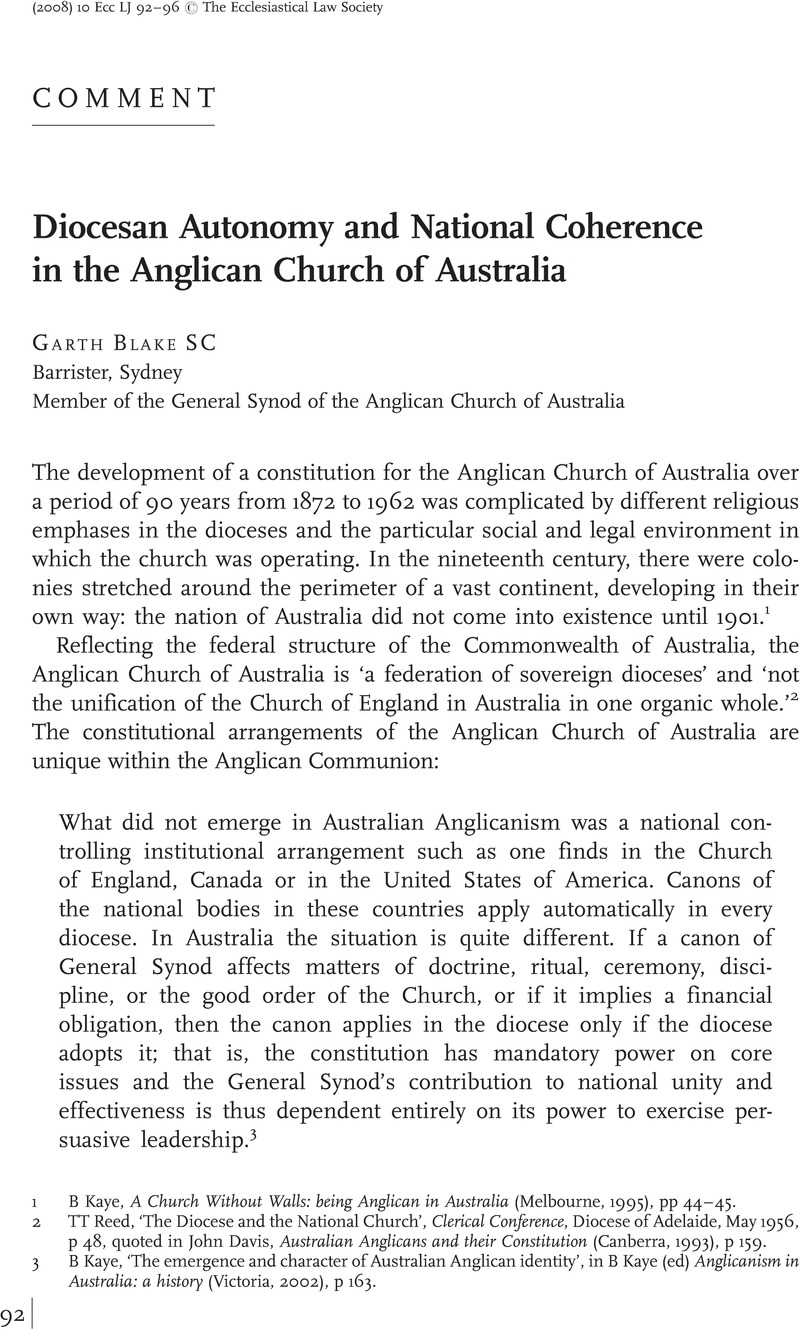No CrossRef data available.
Article contents
Diocesan Autonomy and National Coherence in the Anglican Church of Australia
Published online by Cambridge University Press: 03 December 2007
Abstract

- Type
- Comment
- Information
- Copyright
- Copyright © Ecclesiastical Law Society 2008
References
1 Kaye, B, A Church Without Walls: being Anglican in Australia (Melbourne, 1995), pp 44–45Google Scholar.
2 TT Reed, ‘The Diocese and the National Church’, Clerical Conference, Diocese of Adelaide, May 1956, p 48, quoted in Davis, John, Australian Anglicans and their Constitution (Canberra, 1993), p 159Google Scholar.
3 Kaye, B, ‘The emergence and character of Australian Anglican identity’, in Kaye, B (ed) Anglicanism in Australia: a history (Victoria, 2002), p 163Google Scholar.
4 The Constitution can be found on the website of the Anglican Church of Australia at <http://www.anglican.org.au/docs/ACAConstitution-2003.pdf>, accessed 2 October 2007.
5 The Appellate Tribunal, which is established by s 57(1) of the Constitution, consists of seven members, three of whom are diocesan bishops, and four of whom are laypersons, each of whom must be qualified to be a lay representative of a diocese and must be or have been a judicial officer or legal practitioner of at least ten years' standing. The jurisdiction of the Appellate Tribunal includes determining under s 30(c)(iii) of the Constitution a difference of opinion between a diocese and the Standing Committee of the General Synod whether a Canon affects the order and good government of the Church within a diocese, and determining under s 63 of the Constitution a question arising under the Constitution.
6 The Special Tribunal Canon 2004 can be found on the website of the Anglican Church of Australia at <http://www.anglican.org.au/docs/Canon2004-07SpecialTribunalCanon.pdf>, accessed 2 October 2007.
7 The National Register Canon 2004 can be found at <http://www.anglican.org.au/docs/Canon2004-12NationalRegister.pdf>, accessed 2 October 2007.
8 The determination can be found at <http://www.anglican.org.au/docs/AT2007-4April30dec.pdf>, accessed 2 October 2007.
9 The Special Tribunal Canon Repeal Canon 2007 can be found at <http://www.anglican.org.au/docs/GS07Canon%2012Special%20Tribunal%202004%20Repeal.pdf>, accessed 5 November 2007.
10 The Special Tribunal Canon 2007 can be found at <http://www.anglican.org.au/docs/GS07Canon%2013SpecialTribunalCanon.pdf>, accessed 5 November 2007.
11 The National Register Canon 2007 can be found at <http://www.anglican.org.au/docs/GS07Canon%2015National%20Register%20Canon%202007.pdf>, accessed 5 November 2007.


